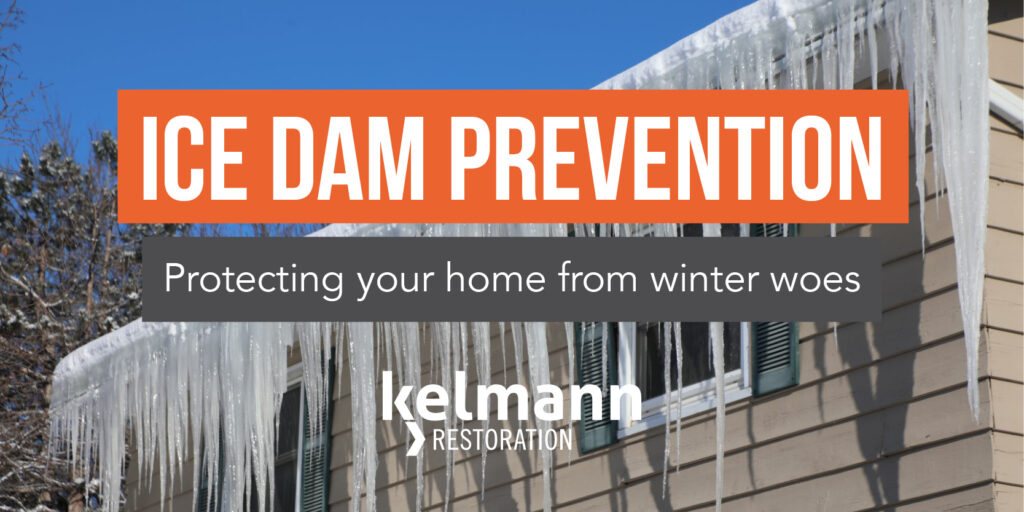Ice Dam Prevention and Remediation: Protecting Your Home from Winter Woes

This past week brought sudden, intense winter weather to Wisconsin. Now that things are beginning to settle and the snow seems to have stopped, we’re dealing with the after-effects of a winter storm: restoring power, recovering from burst pipes and flood damage, and taking care of ice dams.
An ice dam forms when snow on your roof melts and refreezes near the edges, causing a barrier that traps water on your roof. This can lead to big issues for homeowners: water damage, structural issues, and costly repairs. Let’s take a minute to discuss ice dam prevention strategies and what you can do if one develops at your home or business.
Understanding Ice Dams
Before diving into ice dam prevention and remedies, it’s crucial to understand the factors contributing to ice dam formation:
- Snow Accumulation: The more snow that accumulates on your roof, the greater the potential for ice dams.
- Temperature Fluctuations: Fluctuations between freezing and thawing temperatures are a primary catalyst for ice dams. Snow melts during the day and refreezes at night.
- Inadequate Insulation: Poor insulation allows heat from your home to escape into the attic, warming the roof and accelerating snowmelt.
- Inadequate Ventilation: Proper roof ventilation helps maintain consistent temperatures and prevents warm air from accumulating in the attic.
Tips For Ice Dam Prevention
- Maintain Proper Insulation: Ensure your attic is well-insulated to prevent heat from escaping into the attic space. This keeps the roof’s temperature consistent.
- Seal Air Leaks: Seal gaps, cracks, and holes in your attic to prevent warm air from infiltrating. Focus on areas around light fixtures, vents, and plumbing.
- Ventilation: Adequate roof and soffit ventilation can help maintain a uniform temperature on your roof. This can be achieved by installing ridge and soffit vents.
- Roof Raking: Use a roof rake to safely remove snow from the lower three to four feet of your roof after a significant snowfall. This helps minimize the amount of snow available to melt and refreeze at the eaves.
- Heated Cables: If your home is susceptible to ice dams, consider installing heated cables along the eaves and gutters to prevent ice buildup. These cables melt snow and ice, creating channels for water to flow off the roof.
What to Do if an Ice Dam Develops
Despite your ice dam prevention actions, they can still form. When they do, it’s essential to act promptly to minimize damage:
- Remove Snow: Safely remove snow from your roof using a roof rake or a long-handled broom. Always work from the ground and avoid using tools like ice picks that could damage your roof.
- Break Up Ice Dams: Use a calcium chloride ice melt product to break up the ice dam. Fill a pantyhose or sock with the ice melt and place it on the ice dam. This will create channels for water to flow through.
- Keep Gutters Clear: Ensure that your gutters and downspouts remain clear of ice and debris to allow water to flow freely.
- Consult Professionals: If you’re uncomfortable with DIY ice dam removal, or if you suspect damage to your roof, consult roofing professionals or contractors with experience in ice dam remediation.
- Long-term Solutions: After addressing immediate issues, consult a professional to assess and implement long-term solutions to prevent future ice dams, such as improving insulation and ventilation.
Ice dams can be a winter homeowner’s nightmare, but with proper ice dam prevention strategies and swift action when they develop, you can protect your home from water damage and costly repairs. Remember to prioritize insulation, ventilation, and regular snow removal to keep your home safe and warm during the cold months. If an ice dam does form, don’t hesitate to seek professional assistance to address the issue effectively. By taking these steps, you’ll enjoy a cozy, worry-free winter season.
